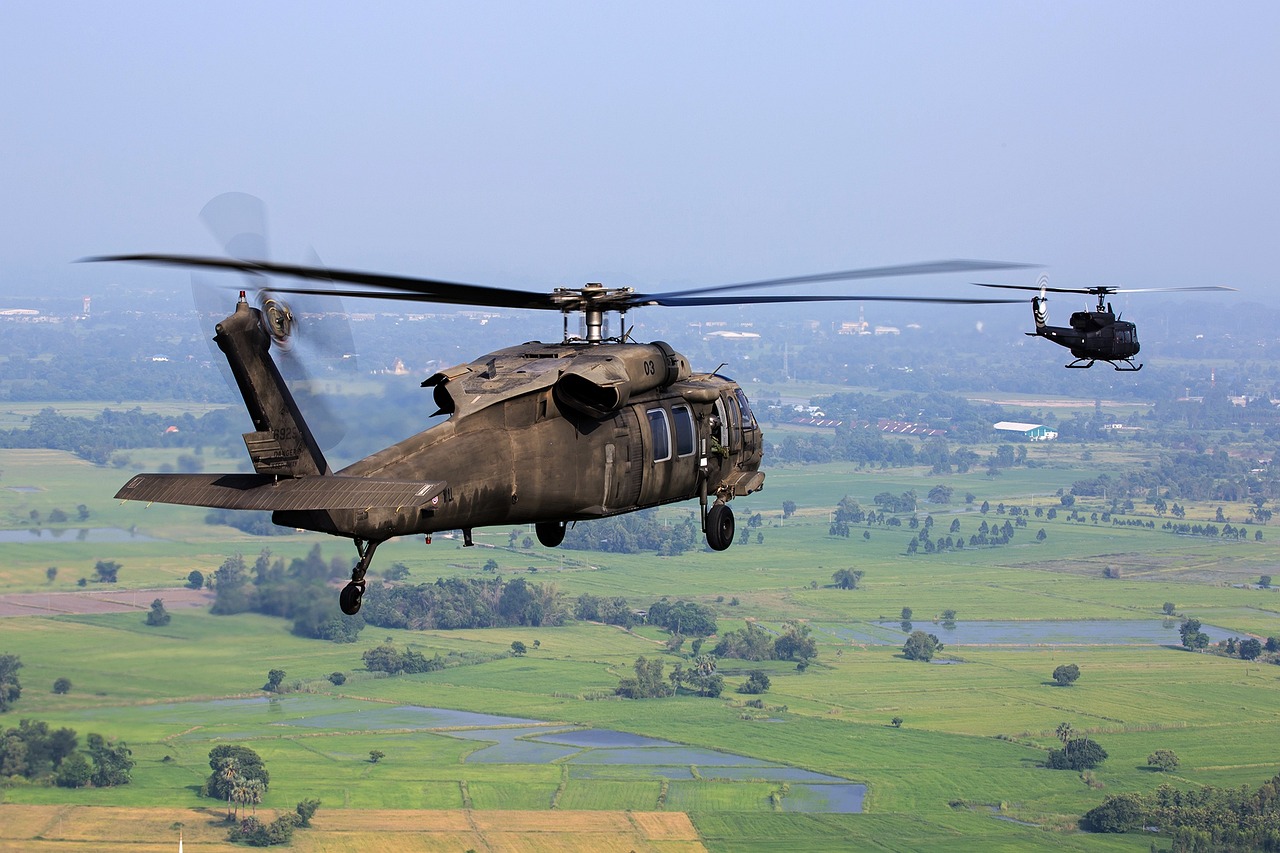How AI is Transforming Military Human Resources
Artificial Intelligence (AI) is no longer just a buzzword; it's a game-changer in various sectors, and military human resources (HR) is no exception. Imagine a world where recruitment processes are as seamless as ordering a pizza online, where training programs are tailored to individual needs like a custom-made suit, and where performance evaluations are as objective as a well-calibrated machine. This is the reality that AI is ushering into military HR, making it more efficient and effective than ever before. In this article, we will explore how AI is reshaping the landscape of military HR, diving into its applications, benefits, challenges, and the exciting future that lies ahead.
Recruitment in the military has traditionally been a labor-intensive process, often bogged down by biases and inefficiencies. However, with the advent of AI technologies, this process is undergoing a significant transformation. AI algorithms can analyze vast amounts of data to identify the best candidates for various roles, streamlining candidate selection processes. This not only enhances job matching but also reduces human biases that can cloud judgment. Picture this: a military recruiter can now focus more on engaging with candidates rather than sifting through endless resumes. AI does the heavy lifting, allowing for a more efficient and effective recruitment strategy.
Training is crucial in the military, and AI-driven programs are taking it to the next level. These intelligent systems provide personalized learning experiences, adapting to individual skill levels and learning styles. For instance, if a soldier struggles with a particular skill, the AI can adjust the training regimen to focus more on that area, ensuring that no one is left behind. This tailored approach significantly improves overall training effectiveness and readiness, ultimately enhancing the military's operational capabilities.
Performance evaluations can often feel subjective and inconsistent. However, AI tools are changing the game by offering more accurate and objective assessments. By analyzing data and identifying patterns, these tools provide military leaders with insights that inform decisions about promotions and career development. Imagine having a clear, data-backed understanding of each soldier's strengths and areas for improvement. This not only helps in making informed decisions but also boosts morale by ensuring that promotions are based on merit rather than favoritism.
The integration of AI into military HR facilitates data-driven decision-making. Military leaders can leverage analytics for strategic planning and resource allocation, enhancing operational efficiency. By predicting future personnel needs and analyzing turnover rates, AI empowers leaders to make informed choices that align with mission requirements. It's like having a crystal ball that offers insights into the future, allowing for proactive rather than reactive management.
Workforce planning is another area where AI shines. By predicting personnel needs and analyzing various factors, AI helps military units remain adequately staffed for diverse missions and operations. For example, if an upcoming deployment requires specialized skills, AI can forecast the personnel needed and recommend training or recruitment strategies to fill those gaps. This level of optimization ensures that military resources are utilized effectively, enhancing overall mission success.
Diversity and inclusion are critical in today's military landscape. AI technologies can play a pivotal role in promoting these values by identifying and mitigating biases in hiring and promotion processes. By analyzing data on candidate backgrounds and performance, AI can help create a more equitable environment for all personnel. This commitment to diversity not only enriches the military culture but also enhances operational effectiveness by bringing together a wide range of perspectives and experiences.
Despite the numerous benefits, implementing AI in military human resources is not without its challenges. Data privacy concerns are paramount, as sensitive information must be handled with care. Additionally, there may be resistance to change from personnel accustomed to traditional methods. Proper training and infrastructure are also essential to ensure that AI tools are utilized effectively. Addressing these challenges is crucial for the successful integration of AI into military HR practices.
Looking ahead, the future of military human resources is likely to see an increased reliance on AI technologies. With advancements in machine learning and data analytics, innovative solutions for personnel management will continue to emerge. As military leaders embrace these technologies, we can expect a more efficient, effective, and inclusive approach to managing human resources in the armed forces.
As AI becomes more integrated into military HR practices, ethical considerations surrounding data usage, algorithmic bias, and the impact on personnel morale must be carefully evaluated. Responsible implementation is key to ensuring that the benefits of AI do not come at the cost of ethical standards. Military leaders must remain vigilant in addressing these concerns to foster trust and maintain a positive organizational culture.
- What are the primary benefits of using AI in military HR? AI enhances recruitment efficiency, improves training effectiveness, provides objective performance evaluations, and facilitates data-driven decision-making.
- How does AI contribute to diversity and inclusion in the military? AI helps identify and mitigate biases in hiring and promotion processes, fostering a more equitable environment.
- What challenges does the military face in implementing AI? Key challenges include data privacy concerns, resistance to change, and the need for proper training and infrastructure.
- What is the future outlook for AI in military HR? The future is likely to see increased reliance on AI technologies, leading to innovative solutions for personnel management.

The Role of AI in Recruitment
In today's fast-paced world, artificial intelligence (AI) is revolutionizing how military recruitment is conducted. Imagine a scenario where the traditional, labor-intensive recruitment process is transformed into a streamlined, efficient system that not only saves time but also enhances the quality of candidates being selected. That's exactly what AI brings to the table. By leveraging advanced algorithms and data analytics, military organizations can now sift through vast pools of applicants more effectively than ever before.
One of the most significant impacts of AI in recruitment is its ability to streamline candidate selection processes. Gone are the days when recruiters had to manually review hundreds of resumes. AI-driven systems can quickly analyze applications, identifying the most qualified candidates based on specific criteria. This not only speeds up the recruitment timeline but also ensures that the best candidates are not overlooked due to human error or unconscious bias.
Moreover, AI technologies enhance job matching by utilizing sophisticated algorithms that consider various factors such as skills, experiences, and personality traits. This means that candidates are matched not just based on their qualifications but also on how well they fit into the military's culture and values. Imagine a perfect puzzle piece fitting seamlessly into a larger picture; that's how AI optimizes the recruitment process.
However, with great power comes great responsibility. While AI can significantly reduce biases in hiring, it is crucial to ensure that the algorithms used are designed to be fair and equitable. If not carefully monitored, AI systems could inadvertently perpetuate existing biases, leading to a lack of diversity within military ranks. Thus, it’s essential for military organizations to focus on developing AI tools that are transparent and accountable.
In addition to enhancing efficiency and reducing biases, AI can also provide valuable insights into the recruitment process. By analyzing data trends, military leaders can identify which recruitment strategies are most effective, allowing them to allocate resources more wisely and adjust their approaches as needed. This data-driven decision-making empowers military HR departments to refine their recruitment strategies continually, ensuring they attract the best talent available.
In summary, AI is not just a tool; it's a game-changer in military recruitment. From streamlining candidate selection to enhancing job matching and reducing biases, the benefits of AI are profound. As military organizations continue to embrace these technologies, we can expect a more efficient, effective, and equitable recruitment process that ultimately strengthens our armed forces.
- How does AI reduce biases in military recruitment? AI systems can analyze data without the inherent biases that human recruiters may have, ensuring a fairer selection process.
- Can AI completely replace human recruiters? While AI can assist significantly, human judgment is essential for understanding the nuances of candidates and organizational culture.
- What are the risks associated with using AI in recruitment? Risks include potential algorithmic bias and data privacy concerns that need to be carefully managed.

Enhancing Training and Development
In the ever-evolving landscape of military operations, training and development are crucial for maintaining a competitive edge. With the integration of artificial intelligence (AI), military training programs are experiencing a remarkable transformation. Imagine a training environment that adapts to each soldier's unique learning style and pace—this is no longer a distant dream but a reality thanks to AI technologies. By utilizing sophisticated algorithms and data analytics, military leaders can create personalized training experiences that cater to individual skill levels.
One of the most significant advantages of AI-driven training is its ability to provide real-time feedback. Traditional training methods often rely on standardized assessments that may not accurately reflect a soldier's capabilities. However, AI systems can analyze performance data continuously, offering insights that help instructors identify areas for improvement. This not only enhances the learning experience but also ensures that soldiers are better prepared for the challenges they will face in the field.
Moreover, AI can simulate various combat scenarios, allowing military personnel to practice decision-making and tactical skills in a controlled environment. These simulations can be tailored to reflect specific missions or potential threats, providing soldiers with a realistic training experience. Imagine training for a complex operation without the risks associated with real-world engagements—this is precisely what AI brings to the table.
To illustrate the impact of AI on military training, consider the following table that highlights key benefits:
| Benefit | Description |
|---|---|
| Personalization | Training programs are tailored to individual learning styles and skill levels. |
| Real-time Feedback | Continuous performance analysis provides immediate insights for improvement. |
| Scenario Simulation | Realistic combat scenarios prepare soldiers for actual missions without risks. |
| Enhanced Engagement | Interactive AI tools make training more engaging and effective. |
Furthermore, AI can enhance the overall effectiveness of training programs by analyzing vast amounts of data to identify trends and patterns. For instance, if a particular training module consistently yields poor results, AI can flag this issue, prompting military leaders to reevaluate the curriculum. This data-driven approach ensures that training remains relevant and effective in preparing soldiers for modern warfare.
However, it’s essential to recognize that the integration of AI in training and development is not without its challenges. As with any technological advancement, there may be resistance from personnel who are accustomed to traditional methods. To successfully implement AI-driven training, military organizations must invest in proper training for instructors and personnel alike. This will not only facilitate a smoother transition but also foster a culture of innovation within the military.
In conclusion, the incorporation of AI into military training and development is revolutionizing how soldiers are prepared for their roles. By offering personalized learning experiences, real-time feedback, and realistic simulations, AI is ensuring that military personnel are not only well-trained but also ready to face the complexities of modern warfare. The future of military training lies in the hands of AI, and it’s an exciting time for those involved in defense and security.
- How does AI personalize military training? AI analyzes individual performance data to tailor training programs according to each soldier's learning style and skill level.
- What are the benefits of AI-driven training simulations? They provide realistic scenarios for soldiers to practice decision-making without the risks associated with real-world engagements.
- What challenges come with implementing AI in military training? Resistance to change and the need for proper training and infrastructure can pose challenges during implementation.

Performance Evaluation and Management
In the ever-evolving landscape of military operations, the importance of cannot be overstated. Traditional methods of assessing personnel often relied on subjective judgments, which could lead to inconsistencies and potential biases. However, with the advent of artificial intelligence, military leaders are now equipped with powerful tools that enable them to conduct performance evaluations that are not only more accurate but also more objective.
AI-driven tools analyze vast amounts of data, providing insights that were previously unattainable. For instance, by examining performance metrics, training outcomes, and even feedback from peers, AI can identify patterns and trends that highlight an individual's strengths and weaknesses. This data-driven approach allows military leaders to make informed decisions regarding promotions, assignments, and career development opportunities. Imagine a world where every soldier's capabilities are understood at a granular level—this is the promise that AI holds for performance evaluation.
Moreover, the integration of AI in performance management fosters a culture of continuous improvement. Instead of waiting for annual reviews, military personnel can receive real-time feedback based on their performance data. This immediacy not only enhances accountability but also encourages a proactive approach to personal and professional development. For example, if an AI system identifies that a soldier excels in leadership during training exercises but struggles with technical skills, targeted training programs can be implemented to address these gaps.
However, while AI offers numerous advantages, it also raises questions about the human element in performance evaluations. Can we fully trust algorithms to understand the nuances of military service? To address this, it’s essential to maintain a balance between AI insights and human judgment. Military leaders must be trained to interpret AI-generated data critically, ensuring that decisions are not solely based on numbers but also consider the context of each individual’s service and contributions.
As we look to the future, the role of AI in performance evaluation and management is likely to expand further. With advancements in machine learning and data analytics, military organizations can expect to see even more sophisticated tools that enhance their ability to assess personnel effectively. This shift will not only improve operational efficiency but also contribute to a more satisfied and engaged workforce.
| Benefits of AI in Performance Evaluation | Challenges to Consider |
|---|---|
| Increased accuracy in assessments | Potential for algorithmic bias |
| Real-time feedback for continuous improvement | Need for proper training on AI tools |
| Data-driven decision-making | Concerns over data privacy |
- How does AI improve performance evaluations? AI enhances evaluations by providing data-driven insights that reduce bias and increase accuracy.
- Can AI replace human judgment in performance assessments? While AI can provide valuable data, human judgment remains crucial for interpreting results in context.
- What challenges does AI face in military HR? Key challenges include data privacy concerns, potential bias in algorithms, and the need for extensive training.
- How can military personnel benefit from AI-driven evaluations? Personnel can receive tailored feedback and development opportunities based on their unique performance data.

Data-Driven Decision Making
In today's fast-paced military environment, has emerged as a game changer. Imagine being able to sift through mountains of data in mere seconds, uncovering insights that can significantly influence strategic planning and operational efficiency. That's the power of artificial intelligence (AI) in the realm of military human resources. By harnessing the capabilities of AI, military leaders can transform raw data into actionable intelligence, paving the way for informed decisions that can affect the outcome of missions.
One of the most compelling aspects of AI is its ability to analyze vast datasets with remarkable speed and accuracy. For instance, consider how AI algorithms can process recruitment data, performance metrics, and even personnel feedback to identify trends and patterns that might otherwise go unnoticed. This analytical prowess allows military HR departments to make decisions based on solid evidence rather than gut feelings or outdated practices. It’s like having a crystal ball that reveals the best course of action based on historical data and predictive analytics.
Moreover, the integration of AI into decision-making processes extends beyond just recruitment and performance evaluations. Military leaders can utilize AI tools to forecast future personnel needs, assess potential skill gaps, and even determine optimal staffing levels for upcoming missions. This level of foresight can mean the difference between success and failure in critical operations. Imagine planning a complex mission with the confidence that your team is not just adequately staffed, but also composed of individuals whose skills perfectly match the requirements of the task at hand.
However, while the benefits of data-driven decision making are immense, it’s also essential to recognize the challenges that come with it. Data privacy concerns loom large, as sensitive personnel information is often involved in the analysis. Military organizations must ensure that they uphold strict data protection standards to maintain trust among service members. Additionally, there is a need for ongoing training to ensure that personnel are not just familiar with AI tools but also understand how to interpret the data these systems generate.
To illustrate the impact of data-driven decision making in military HR, consider the following table:
| Aspect | Traditional Approach | AI-Driven Approach |
|---|---|---|
| Data Analysis | Manual review of reports | Automated data processing and insights generation |
| Decision Speed | Time-consuming | Real-time analysis |
| Outcome Accuracy | Subject to human error | Data-backed accuracy |
| Resource Allocation | Reactive | Proactive and predictive |
As we look to the future, the military's reliance on data-driven decision making is only expected to grow. The integration of AI technologies will continue to evolve, offering even more sophisticated tools for analysis and insight generation. This evolution will not only enhance operational efficiency but also support a culture of continuous improvement within military HR practices. As leaders become more adept at leveraging data, the military will be better positioned to adapt to the ever-changing landscape of modern warfare.
- What is data-driven decision making? Data-driven decision making involves using data analysis to guide strategic decisions, ensuring that choices are based on evidence rather than intuition.
- How does AI contribute to data-driven decision making in the military? AI enhances data analysis by quickly processing large datasets, identifying patterns, and generating insights that inform decisions.
- What are the challenges of implementing AI for decision making? Challenges include data privacy concerns, the need for proper training, and potential resistance to change from personnel.
- Why is data privacy important in military HR? Protecting sensitive personnel information is crucial for maintaining trust and ensuring compliance with legal standards.

Workforce Planning and Optimization
In the dynamic environment of military operations, are crucial for maintaining readiness and effectiveness. With the integration of artificial intelligence (AI), military human resources can now predict personnel needs with remarkable accuracy. Imagine having a tool that not only anticipates the number of troops required for a specific mission but also considers the unique skills and experiences of each service member. This is not just a dream; it is becoming a reality thanks to AI technologies.
One of the primary advantages of AI in workforce planning is its ability to analyze vast amounts of data. By examining historical trends, operational demands, and even external factors such as geopolitical changes, AI can provide insights that were previously unimaginable. For instance, if a particular unit has a history of high turnover during specific training cycles, AI can flag this and suggest interventions to improve retention. This proactive approach helps military leaders make informed decisions that align personnel capabilities with mission requirements.
Moreover, AI can optimize staffing levels by evaluating current personnel deployment against future mission needs. This involves not just counting heads but also assessing the skills and readiness of each service member. For example, if a mission requires specialized skills in cyber warfare, AI can identify which personnel are best suited for the task, ensuring that the right people are in the right place at the right time. This level of optimization can dramatically enhance operational efficiency and effectiveness.
Another fascinating aspect of AI-driven workforce planning is its capacity to simulate various scenarios. Military leaders can input different variables—such as changes in mission objectives, personnel availability, or even unexpected global events—and the AI can model outcomes. This enables commanders to visualize potential challenges and devise strategies to mitigate risks. In a world where every decision can have significant consequences, this capability is invaluable.
However, it’s essential to recognize that while AI presents numerous opportunities, it also requires a cultural shift within military organizations. Embracing AI means adapting to new technologies and methodologies, which can sometimes meet with resistance. Training personnel to work alongside AI tools is crucial for maximizing their potential. Additionally, the integration of AI must be accompanied by clear guidelines to ensure that ethical considerations—such as data privacy and algorithmic bias—are addressed.
In conclusion, the integration of AI into workforce planning and optimization is transforming military human resources. By harnessing data analytics and predictive modeling, military leaders can make more informed decisions, ultimately enhancing the effectiveness of their operations. As we look to the future, the importance of AI in workforce management will only continue to grow, paving the way for a more agile and responsive military force.
- How does AI improve workforce planning in the military?
AI enhances workforce planning by analyzing data to predict personnel needs, optimizing staffing levels, and simulating various operational scenarios. - What challenges come with implementing AI in military HR?
Challenges include resistance to change, the need for proper training, and addressing ethical considerations such as data privacy and algorithmic bias. - Can AI help with personnel retention?
Yes, AI can identify patterns in turnover rates and suggest interventions to improve retention strategies. - What role does data play in AI-driven workforce optimization?
Data is crucial as it provides the insights necessary for AI to make accurate predictions and recommendations regarding personnel management.

Addressing Diversity and Inclusion
Diversity and inclusion are not just buzzwords; they are essential components of a thriving military organization. As the landscape of warfare and defense evolves, so does the need for a workforce that reflects the diverse society it serves. Artificial Intelligence (AI) plays a pivotal role in this transformation by identifying and mitigating biases that have historically plagued hiring and promotion processes. Imagine a world where every candidate is assessed on their merits rather than their background—this is the promise AI holds for military human resources.
One of the most significant advantages of AI in promoting diversity is its ability to analyze vast amounts of data to identify patterns and biases. For instance, traditional recruitment methods may inadvertently favor certain demographics over others, leading to a lack of representation. AI algorithms can examine historical hiring data to pinpoint these biases, allowing military HR departments to adjust their strategies accordingly. By doing so, they can create a more equitable hiring process that opens doors for underrepresented groups.
Moreover, AI can enhance job matching by focusing on skills and qualifications rather than demographic factors. This approach not only helps in attracting a broader range of candidates but also ensures that the best talent is selected for the job. When military organizations utilize AI-driven tools, they can streamline their recruitment processes, making them more efficient and less prone to human error. This efficiency is crucial, especially in high-stakes environments where the right personnel can make all the difference.
Furthermore, AI can assist in developing training programs that are inclusive and tailored to diverse learning styles. By analyzing individual performance data, AI can identify specific needs and preferences, creating a personalized learning experience for all personnel. This adaptability not only fosters a sense of belonging but also enhances the overall effectiveness of training initiatives. As military personnel feel more included and valued, their morale and performance are likely to improve, leading to a more cohesive unit.
However, while AI presents numerous opportunities for enhancing diversity and inclusion, it is essential to approach its implementation with caution. The algorithms powering these AI systems must be carefully designed to avoid perpetuating existing biases. Continuous monitoring and evaluation of AI tools are necessary to ensure that they are functioning as intended and promoting fairness. In this regard, collaboration between military leaders, data scientists, and diversity experts is crucial to create a balanced approach that champions inclusivity.
In conclusion, addressing diversity and inclusion within military human resources through AI is not merely a strategic advantage; it is a moral imperative. By leveraging technology to create fairer recruitment and promotion processes, military organizations can foster a culture that values every individual’s contribution. This commitment to diversity not only enhances operational effectiveness but also reflects the core values of the military—integrity, respect, and excellence.
- How does AI help in reducing biases in recruitment?
AI analyzes historical data to identify patterns of bias, allowing organizations to adjust their hiring processes to be more equitable. - Can AI improve training programs for diverse personnel?
Yes, AI can create personalized training experiences that cater to different learning styles, ensuring that all personnel receive effective training. - What are the risks associated with using AI in HR?
Potential risks include algorithmic bias and data privacy concerns, which necessitate careful monitoring and ethical considerations. - How can military organizations ensure AI promotes diversity?
By involving diversity experts in the development and evaluation of AI tools, organizations can better align their technology with their diversity goals.

Challenges of Implementing AI
While the integration of artificial intelligence (AI) into military human resources presents a plethora of opportunities, it also brings a unique set of challenges that cannot be overlooked. One of the most significant hurdles is the issue of data privacy. In a military context, sensitive information about personnel is often involved, and ensuring that this data is secure from breaches is paramount. The military must navigate complex regulations and ethical considerations surrounding the collection, storage, and usage of personal data. As AI systems require vast amounts of data to function effectively, the balance between operational efficiency and data security becomes a tightrope walk.
Another challenge lies in the resistance to change. The military has a long-standing tradition and established processes that have been honed over years of experience. Introducing AI into these processes can be met with skepticism from personnel who may fear that technology will replace human judgment or lead to job losses. This cultural resistance can impede the adoption of AI solutions, making it essential for military leaders to foster a mindset open to innovation and change. Engaging personnel in the conversation about AI and demonstrating its benefits can help alleviate fears and promote acceptance.
Moreover, the successful implementation of AI requires a solid foundation of training and infrastructure. Many military units may lack the necessary technological infrastructure to support advanced AI systems. This gap can lead to uneven implementation across different branches or units, further complicating integration efforts. Additionally, personnel must be adequately trained to work with these new technologies, which involves not only technical skills but also an understanding of how to interpret AI-driven insights. Without proper training programs, the potential of AI may remain untapped.
Another notable challenge is algorithmic bias. AI systems are only as good as the data they are trained on. If historical data contains biases, the AI can perpetuate and even amplify these biases in decision-making processes. This is particularly concerning in recruitment and promotion, where biased algorithms can undermine the military's efforts to foster a diverse and inclusive environment. Addressing this challenge requires continuous monitoring and refinement of AI systems to ensure fairness and equity in outcomes.
Finally, the cost of implementation cannot be ignored. Developing and deploying AI solutions can be a substantial financial investment. For military organizations operating under budget constraints, justifying the costs associated with AI technology can be a significant barrier. Leaders must weigh the long-term benefits against the initial expenditures, making a compelling case for the return on investment that AI can provide.
In summary, while AI holds transformative potential for military human resources, the challenges of data privacy, resistance to change, infrastructure requirements, algorithmic bias, and implementation costs must be carefully navigated. Addressing these hurdles is crucial for the successful integration of AI technologies, ensuring that they enhance rather than hinder military operations.
- What are the main challenges of implementing AI in military HR?
The primary challenges include data privacy concerns, resistance to change, infrastructure requirements, algorithmic bias, and the costs associated with implementation.
- How can data privacy be ensured when using AI?
Data privacy can be ensured by adhering to strict regulations, implementing robust security measures, and regularly auditing AI systems to protect sensitive information.
- What can be done to overcome resistance to AI in the military?
Engaging personnel through education, demonstrating the benefits of AI, and involving them in the implementation process can help overcome resistance.

Future Trends in Military HR
The landscape of military human resources is on the brink of a revolutionary transformation, largely driven by the rapid advancements in artificial intelligence (AI). As we look ahead, it's clear that AI will not just play a supporting role but will fundamentally reshape how military organizations manage their personnel. Imagine a future where decision-making is not only faster but also more precise, thanks to data analytics and machine learning algorithms. This is not just a dream; it's becoming a reality.
One of the most exciting trends is the evolution of predictive analytics. This technology enables military HR departments to forecast personnel needs and identify potential challenges before they arise. For instance, by analyzing historical data on enlistment and attrition, AI can provide insights into when and where additional personnel may be needed, ensuring that military units are always mission-ready. This proactive approach can significantly enhance operational efficiency and readiness.
Furthermore, AI-driven personalized career development is set to become a standard practice. Imagine each service member having a tailored career path that aligns with their skills, aspirations, and the needs of the military. AI can analyze individual performance data and suggest training programs, mentorship opportunities, and even potential promotions that best fit each person's unique profile. This not only boosts morale but also ensures that the military is utilizing its human resources to their fullest potential.
Another promising trend is the integration of virtual and augmented reality (VR/AR) in training and simulations. These technologies, powered by AI, can create immersive training environments that mimic real-world scenarios. This allows military personnel to practice their skills in a safe yet realistic setting, enhancing their preparedness for actual missions. The ability to analyze performance in these simulations through AI can lead to further refinements in training programs, making them more effective than ever.
Moreover, the focus on diversity and inclusion within military ranks is likely to intensify. AI can play a crucial role in identifying and addressing biases in hiring and promotion practices. By analyzing data from various stages of the recruitment process, AI can help ensure that all candidates are evaluated fairly, ultimately fostering a more inclusive environment. This not only benefits the individuals involved but also enhances the overall effectiveness of the military by bringing diverse perspectives to the table.
However, as we embrace these advancements, it's essential to remain vigilant about the ethical implications of AI in military HR. Issues such as data privacy, algorithmic bias, and the potential for job displacement must be carefully considered. The military will need to establish robust frameworks to govern the use of AI, ensuring that these technologies are implemented responsibly and transparently.
In conclusion, the future of military human resources is bright, with AI leading the charge toward more efficient, effective, and equitable personnel management. As we continue to explore these trends, one thing is clear: the integration of AI into military HR practices will not only enhance operational capabilities but also create a more dynamic and responsive workforce ready to meet the challenges of tomorrow.
- What is the role of AI in military HR?
AI streamlines processes such as recruitment, training, performance evaluation, and workforce planning, making military HR more efficient and effective. - How will AI impact military training?
AI-driven training programs will provide personalized experiences, adapting to individual learning styles and skill levels, thereby enhancing overall readiness. - What ethical considerations are there with AI in military HR?
Key concerns include data privacy, algorithmic bias, and ensuring that AI is used responsibly to avoid negative impacts on personnel morale. - Will AI replace human roles in military HR?
While AI will automate certain tasks, it is more likely to augment human roles, allowing HR professionals to focus on strategic decision-making.

Ethical Considerations in AI Usage
As the military increasingly embraces artificial intelligence (AI) within its human resources practices, it becomes paramount to address the ethical considerations that arise. The integration of AI is not just about efficiency and optimization; it also brings forth a plethora of moral dilemmas that must be navigated with care. For instance, how do we ensure that the data collected and analyzed by AI systems is used responsibly? What measures are in place to protect the privacy of military personnel while still leveraging their data for enhanced decision-making? These questions are fundamental as we explore the intersection of technology and ethics in the military context.
One of the most pressing issues is algorithmic bias. AI systems learn from historical data, and if that data contains biases—whether intentional or unintentional—the AI can perpetuate or even exacerbate these biases in recruitment, promotions, and evaluations. For example, if previous hiring practices favored certain demographics, the AI might continue to favor those groups unless corrective measures are taken. This calls for rigorous testing and validation of AI algorithms to ensure they promote equity and do not reinforce existing disparities.
Moreover, the impact of AI on personnel morale cannot be overlooked. When decisions about promotions or job placements are made by algorithms, it can lead to feelings of alienation among service members. They may question whether their skills and contributions are truly recognized or if they are merely numbers in a data set. This sentiment can be detrimental to unit cohesion and overall effectiveness. Therefore, it is crucial to maintain a balance between data-driven decision-making and human judgment, ensuring that personnel feel valued and understood.
Another key aspect is data privacy. The military handles sensitive information, and the implementation of AI must prioritize the protection of this data. There should be clear policies regarding who has access to personnel data, how it is used, and how long it is retained. Transparency in these processes can help build trust among military personnel, assuring them that their information is being handled responsibly.
Additionally, ethical considerations must also encompass the accountability of AI systems. If an AI system makes a flawed decision that adversely affects a service member’s career, who is held responsible? Is it the developers of the AI, the military leaders who implemented it, or the system itself? Establishing accountability frameworks is essential to ensure that there are clear lines of responsibility and that personnel can seek redress when necessary.
In conclusion, while AI holds immense potential to transform military human resources, it is imperative to approach its implementation with a keen awareness of the ethical ramifications. By actively addressing issues such as algorithmic bias, personnel morale, data privacy, and accountability, the military can harness the benefits of AI while upholding the values of integrity and responsibility.
- What are the main ethical concerns regarding AI in military HR? The main concerns include algorithmic bias, data privacy, personnel morale, and accountability for AI decisions.
- How can biases in AI algorithms be mitigated? By rigorously testing and validating AI systems against diverse datasets and continuously monitoring their outcomes to ensure fairness.
- What measures can be taken to protect personnel data? Establishing clear policies on data access, usage, and retention while ensuring transparency can help protect personnel data.
- Why is personnel morale important in the context of AI? High personnel morale is crucial for unit cohesion and effectiveness; if personnel feel undervalued due to AI decisions, it can harm overall performance.
Frequently Asked Questions
- How is AI changing military recruitment?
AI is revolutionizing military recruitment by streamlining the selection process. It enhances job matching and reduces biases, leading to a more effective recruitment strategy. Imagine a smart assistant that sifts through countless applications, highlighting the best candidates based on their skills and experience!
- What are the benefits of AI in training and development?
AI-driven training programs offer personalized learning experiences for military personnel. They adapt to individual skill levels and learning styles, making training more effective. Think of it like having a personal trainer who knows exactly what you need to improve and tailors the workout just for you!
- How does AI improve performance evaluation?
AI tools analyze data and identify patterns to provide accurate and objective performance evaluations. This allows military leaders to make informed decisions regarding promotions and career development. It’s like having a crystal ball that reveals who truly stands out based on hard data!
- Can AI assist in data-driven decision-making?
Absolutely! The integration of AI in human resources empowers military leaders to leverage analytics for strategic planning and resource allocation. It’s akin to having a GPS that guides you through the best routes to achieve your mission efficiently!
- How does AI help with workforce planning?
AI predicts personnel needs, analyzes turnover rates, and optimizes staffing levels, ensuring military units are adequately staffed for missions. Imagine having a tool that forecasts your team’s needs before they even arise—now that’s forward-thinking!
- What role does AI play in promoting diversity and inclusion?
AI technologies can identify and mitigate biases in hiring and promotion processes, fostering a more equitable environment. It’s like having a fair referee in a game, ensuring everyone plays by the same rules!
- What challenges come with implementing AI in military HR?
Challenges include data privacy concerns, resistance to change, and the need for proper training and infrastructure. It’s like trying to introduce a new game to a team that’s used to the old ways—it takes time and patience!
- What future trends should we expect in military HR?
The future of military HR will likely see increased reliance on AI technologies, with advancements in machine learning and data analytics driving innovative solutions for personnel management. Think of it as a continuous evolution, where each new technology builds on the last!
- Are there ethical considerations in AI usage?
Yes, as AI becomes more integrated into military HR practices, ethical considerations regarding data usage, algorithmic bias, and personnel morale must be evaluated. It’s crucial to ensure that the implementation of AI is responsible and respects the dignity of all personnel involved.



















